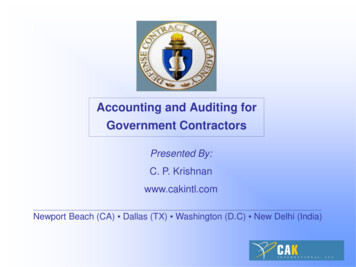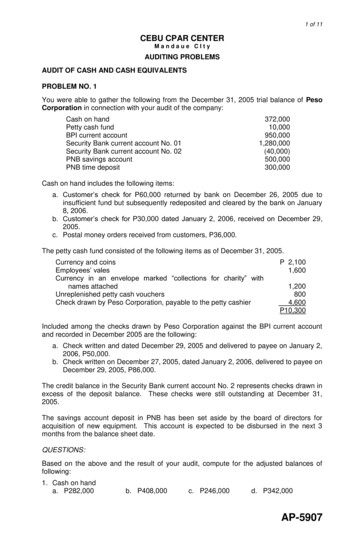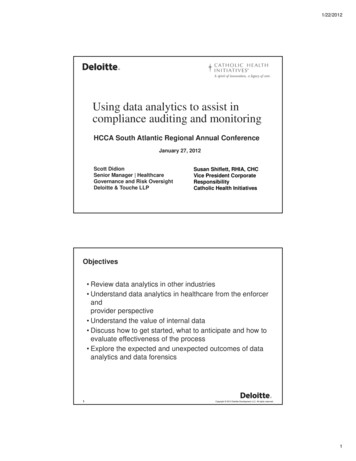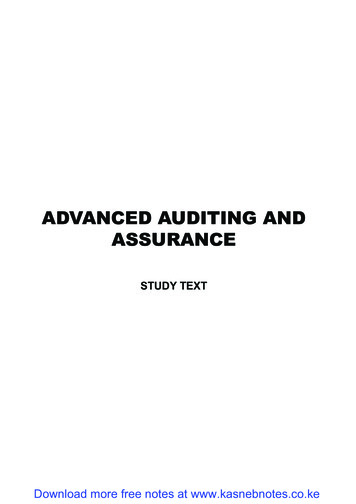
Transcription
Accounting and Auditing forGovernment ContractorsPresented By:C. P. Krishnanwww.cakintl.comNewport Beach (CA) Dallas (TX) Washington (D.C) New Delhi (India)
Accounting and Auditing for Government ContractorsFor more info www.cakintl.comwww.sba.gov
Accounting and Auditing for Government ContractorsWho is DCAA?The Defense Contract AuditAgency, operates under theauthority, direction, and controlof the Under Secretary ofDefense (Comptroller),(USD(C)) / Chief FinancialOfficer (CFO), Department ofDefense.www.cakintl.com
Accounting and Auditing for Government ContractorsFederal Acquisition Regulation (FAR)Statutory authorities to issue and revise the FAR havebeen delegated to the Procurement Executives in DoD,GSA and NASA. FAR applies to all agencies includingthe Executive Branch. The Legislative and Judicialbranches are not required to comply with the FAR, buttend to follow it in spirit and content. These provisionsinclude requirements for:- Changing the scope of work- Terminating contracts- Making payments- Testing and acceptance of delivered goods/serviceswww.cakintl.com
Accounting and Auditing for Government ContractorsWhat Constitutes DCAA Compliance- Identifying and evaluating all activities that eithercontribute to or have an impact on proposed or incurredcosts of government contracts.-Financial Policies, Procedures, and Internal controls.- Identify opportunities to reduce or avoid costs.
FAR Cost PrinciplesFAR Part 31 - A chronology that is used to determinethe cost principles in effect at time of contract awardthat may be necessary for audits of historical costs. Itcan be found at www.dcaa.milwww.cakintl.com
Accounting and Auditing for Government ContractorsContract Types- Fixed Price Contracts- Cost Contracts- Incentive Contracts- Indefinite Delivery Indefinite Quantity (IDIQ)- Time & Material, Labor Hour, Letter Contractswww.cakintl.com
Accounting and Auditing for Government ContractorsContract Accounting Terms- Invoicing, Recieving,and Property Transfer(iRAPT formerly WAWF)- Vouchers (Invoices)- Cost Accounting Standards (CAS)- Incurred Cost Electronically (ICE)- Cost Accumulation- Indirect Costswww.cakintl.com
Accounting and Auditing for Government ContractorsAudit Emphasis(1) internal control systems & management policies,(2)(3)(4)(5)accuracy and reasonableness of cost representations,adequacy and reliability of records/accounting systems,financial capability, andcontractor compliance with contractual provisions such as CASand the Truth in Negotiations Act.The extent of DCAA's involvement is determined by the type ofcontract that will be awarded. Generally, most DCAA efforts on firmfixed price type contracts take place during the proposal stagerather than in the incurred cost stage. The reverse is true forflexibly priced contracts.www.cakintl.com
Accounting and Auditing for Government ContractorsPrimary Areas of Accounting Compliance- Pre-award Audits of Contractor Accounting Systems- Accumulation of CostsDirect vs. IndirectBy Contract & CLINLogically, Consistency, Allowability- General Ledger Control- Timekeeping & Labor Distribution system- Uncompensated Overtime- Monthly Closing of financial books- Unallowable Costs- GAAP Overrides Tax allowabilitywww.cakintl.com
Accounting and Auditing for Government ContractorsDefining Cost StructuresDirect costs are defined in FAR 31.202 as any cost that can beidentified specifically with a particular final cost objective (e.g., acontract). An example would be labor specifically identified to thecontract, or materials purchased specifically for the contract.Indirect costs are defined in FAR 31.203 as any cost not directlyidentified with a single, final cost objective, but identified with two ormore final cost objectives or an intermediate cost objective.Overhead CostsCosts that are incurred for or that only benefit an identifiable unit oractivity of the contractor internal organization such as a engineeringdepartment are considered overhead costs. It is common to findseparate overhead pools for engineering, manufacturing, materialhandling, and for certain off-site activities.www.cakintl.com
Accounting and Auditing for Government ContractorsDefining Cost StructuresExamples of overhead pool costs are:- Department supervision- Training of department employees- Fringe benefits of department employeesG&A CostG&A expenses represent the cost of activities that are necessary tothe overall operation of the business as a whole, but for which adirect relationship to any particular cost objective cannot be shown.G&A includes the top management functions Typically, it includeshuman resources, accounting, public relations, contractadministration, legal, etc.www.cakintl.com
Accounting and Auditing for Government ContractorsDefining Cost StructuresFacilities Capital Cost of Money (cost of capital committedto facilities) is an imputed cost. It is allowable whether or notthe contract is otherwise subject to cost accountingstandards (CAS).Other Indirect Cost Pools- IRAD- Bids & Proposals- Manufacturing Overhead- Fringe Benefitswww.cakintl.com
Accounting and Auditing for Government ContractorsDefining Cost StructuresUnallowable ExpensesExpenses that are legitimate business expenses however arenot allowed on government contracts. Examples include:-GSA IFF Fees-Federal Taxes-Interest Expenses-Donations-Penalties & Fines-Employee MoraleUncompensated OvertimeIt the unpaid hours worked over the standard 40 hours for exemptFAR 52.237-10 requires that all hours worked are recordedwhether paid or not. This is necessary because labor costs andoverhead are affected by total hours worked.www.cakintl.com
Accounting and Auditing for Government ContractorsAccumulation of Direct & Indirect Costsa. Proper segregation of direct from indirect costs.DCAA will review the accounting system todetermine if direct costs are segregated fromindirect costs.Indirect costs are normally placed in an overheador general and administrative G&A) expense pooland allocated to contracts on some equitablebasis. Once these criteria are defined, they mustbe consistently applied.www.cakintl.com
Accounting and Auditing for Government ContractorsAccumulation of Costsb. Identification and accumulation of direct costs by contract.DCAA will determine if the accounting system can accumulatecosts by contract (commonly referred to as a job order costaccounting system).c. A logical and consistent method for the allocation of indirect coststo cost objectives. DCAA will determine if indirect costs areallocated to cost objectives based upon relative benefits received,or other equitable relationship. Fundamentally, this means that acost may not be allocated as an indirect cost to a final costobjective if other costs incurred for the same purpose have beenincluded as direct costs of that or any other cost objective.www.cakintl.com
Accounting and Auditing for Government ContractorsAccumulation of Costsd. Accumulation of costs under general ledger control. DCAA willdetermine if the job order cost accounting system can bereconciled with the general ledger, and that the companyaccounting system is controlled by the general ledger.e. A timekeeping system that identifies employees' labor bycost objectives. DCAA will determine whether a contractor'stimekeeping system has the ability to track employees' timespent on each work activity.www.cakintl.com
Accounting and Auditing for Government ContractorsAccumulation of Costsf. A labor distribution system that charges direct and indirectlabor to the appropriate cost objectives.Once an employee's time is segregated, the costs must beallocated to the appropriate cost objectives.g. Interim (at least monthly) determination of costs chargedto a contract through routine posting to books of account.DCAA will determine if the accounting system produces appropriatereports that show the results of charges to contracts. These reportsshould be produced at least monthly.www.cakintl.com
Accounting and Auditing for Government ContractorsAccounting System & Labor EvaluationsPre-award Surveys of Contractor Accounting Systems-Financial capability audits are performed to determine if thecontractor is financially capable of performing on Governmentcontracts. Reports including financial statements, lendinginstitutions, SEC filings, cash flow forecasts, loan agreements,aging of accounts receivable and payable, financial history of thecontractor and affiliated concerns, and payroll tax returns.The pre-award accounting system survey is to determinethe acceptability of the accounting system for accumulating costsunder a Government contract.www.cakintl.com
Accounting and Auditing for Government ContractorsQuickBooks Setup BasicsCompliant Chart of Accounts- Standard Balance Sheet Accounts- COGS (tracking direct costs, project related)- Most common indirect cost pools- Fringe (use all productive labor as the base)- Overhead (use direct labor as base)- General & Administrative (use total cost input as base)- Unallowable Costs (FAR Part 31.205)Indirect Costs – Approved Structure from DCAA is aminimum of 3 Rate Structure – Fringe, Overhead, and G&Apool. The G&A Pool can be further divided into sub pools –Facilities, Sales & Marketing, Finance & Admin, Bids &Proposal, Independent Research & Development.www.cakintl.com
Accounting and Auditing for Government ContractorsQuickBooks Setup BasicsPayroll ItemsAll Wages will be setup as Hourly Wages for DCAA purposes.Payroll Items will need to be setup for Direct, Overhead, and allG&A wages categories. Uncompensated Wages will also be setupunder both Overhead and G&A categoriesEmployee Setup will involve assigning employee wages to specificpayroll item accounts. Payroll Items are mapped to GL accounts.**QuickBooks is not a DCAA Approved Compliant System.However the correct setup of the system can derive acceptablereporting for DCAA.www.cakintl.com
Accounting and Auditing for Government ContractorsAccounting System & Labor EvaluationsTime Card ComplianceDetailed instructions for timecard preparation should beestablished through a timekeeping company procedure.- Recording his/her time on a daily basis.- Recording time on the timecard in ink.- The correct distribution of time by project numbers, contractnumber or name for a particular assignment.- Changes to the timecard should be lined through, with theemployee's initials beside the change.- Recording all hours worked whether they are paid or not.This is necessary because labor costs and overheads are affectedby total hours worked, not just paid hours worked. Unpaid hoursworked are termed "uncompensated overtime."www.cakintl.com
Accounting and Auditing for Government ContractorsiRapt, ICE, and PBRIncurred Cost Electronically (ICE)The Allowable Cost And Payment clause (FAR 52.216-7) requiresthat the contractor submit an adequate final incurred cost proposaltogether with supporting data, within 6 months after the end of itsfiscal year. The receipt of a proposal by the audit office starts theaudit process. If the proposal is inadequate the auditor will notifythe contractor of the deficiencyThe audit will include an evaluation of both direct and indirectcosts. The audit objective is to examine contractor costrepresentations to determine whether such costs are: reasonable,allocable to the contract, in accordance with GAAP and CostAccounting Standards (CAS), and not prohibited by the contract,Government statute, or regulation.www.cakintl.com
Accounting and Auditing for Government ContractorsBest Practices to PASS any DCAA Audit / TestKnowledge is KingGAAP PrinciplesReconciliations and dataintegrityFinancial statementsPrepaid & accrualsAccounting system complianceMonth end close functionsAudit schedules and third partyvalidationsDCAA Policies & ProceduresUncompensated Overtimewww.cakintl.com
Accounting and Auditing for Government ContractorsQUESTIONSwww.cakintl.com
**QuickBooks is not a DCAA Approved Compliant System. However the correct setup of the system can derive acceptable reporting for DCAA. www.cakintl.com Accounting and Auditing for Government Contractors Accou











